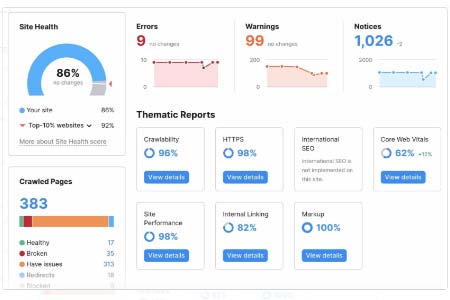Table of Contents
- Uptime Website Monitoring
- Downtime Website Monitoring
- » Server Ping Monitoring
Server ping monitoring is a method of checking the availability of a server by sending a ping request to the server at regular intervals. A ping is a network utility that sends an ICMP (Internet Control Message Protocol) packet to a server to test its availability. Server ping monitoring involves sending a ping request to the server and waiting for a response. If the server responds, it is considered available, and if it does not respond, it is considered unavailable.

Server ping monitoring is an essential part of server monitoring because it provides real-time information about the availability and performance of a server. It allows administrators to identify issues quickly and take appropriate action to resolve them before they escalate into more significant problems.
Checking broken links of website
Checking for broken links is an essential aspect of website maintenance as broken links can negatively affect user experience and SEO. A broken link is a link that leads to a page that no longer exists or has been moved, resulting in a 404 error message. By identifying and fixing broken links, website owners can improve user experience, increase website traffic, and boost SEO. In this article, we will discuss how to check for broken links on a website.
-
Manual Check:
The simplest way to check for broken links on a website is to manually check each page of the website for broken links. This involves clicking on each link on the website and checking if it leads to a valid page or not. However, this method can be time-consuming for the website owners and may not be feasible for the larger websites.
-
Use Website Audit Tools:
Website audit tools such as Ahrefs, SEMrush, and Screaming Frog can quickly identify broken links. These tools crawl the website and generate a report that lists all the broken links and their location. The reports also provide additional information such as the HTTP status code and the anchor text used for the broken link.
-
Use Online Link Checkers:
Online link checkers such as Broken Link Checker and Dead Link Checker can also help identify broken links on a website. These tools work by crawling the website and checking each link for validity. They generate a report that lists all the broken links found on the website, making it easy to fix them.
-
Use Browser Extensions:
Browser extensions such as Check My Links and Link Checker can be used to check for broken links on a website. These extensions scan the website for broken links and highlight them. They also provide other information such as HTTP status code and the anchor text used for the broken link.
-
Use Google Search Console:
Google Search Console is a free tool provided by Google that can be used to check for broken links on a website. It provides a report that lists all the broken links found on the website, as well as other information such as crawl errors and search analytics. Website owners can use this information to identify and fix broken links.
-
Set up Alerts:
Website owners can set up alerts to notify them when broken links are found on the website. These alerts can be set up using website audit tools, Google Analytics, or Google Search Console. They can be sent via email or text message, allowing website owners to take immediate action to fix the broken links.
In conclusion, manual checks, website audit tools, online link checkers, browser extensions, Google Search Console, and setting up alerts are some of the ways to check for broken links on a website.
Benefits of Server ping monitoring
-
 Real-Time Monitoring:
Real-Time Monitoring:
Server ping monitoring provides real-time monitoring of server availability. By sending ping requests at regular intervals, server ping monitoring can identify issues as soon as they occur, allowing administrators to take immediate action to resolve them.
-
Early Detection of Server Downtime:
Server ping monitoring can detect server downtime as soon as it occurs. If the server does not respond to a ping request, it is considered unavailable. This allows administrators to detect server downtime early and take appropriate action to resolve the issue.
-
Reduced Downtime:
By detecting server downtime early, server ping monitoring can help reduce downtime. It allows administrators to take quick action to resolve issues before they escalate into more significant problems, reducing the amount of time the server is unavailable.
-
Improved Server Performance:
Server ping monitoring can help improve server performance by identifying performance issues as soon as they occur. By monitoring the response time of ping requests, administrators can identify slow response times and take appropriate action to improve server performance.
-
Increased Reliability:
Server ping monitoring can increase server reliability by ensuring that the server is always available. By detecting issues early and taking appropriate action to resolve them, administrators can ensure that the server is reliable and always available.
Server ping monitoring can be performed manually by sending ping requests from a command prompt or using automated tools that can send ping requests at regular intervals.
In conclusion, server ping monitoring provides real-time monitoring, early detection of server downtime, reduced downtime, improved server performance, and increased reliability. Automated server ping monitoring tools can provide additional features such as alerting, reporting, and performance monitoring, making them more effective for server monitoring.
Tracert monitoring server and website
Tracert (short for "traceroute") is a command-line tool that can help with monitoring servers and websites. It works by sending a series of packets to the target server or website and then displaying the route that the packets take, along with the response times for each hop in the route. By analyzing this information, network administrators can identify network connectivity issues and troubleshoot performance problems. In this article, we will explore how tracert helps with monitoring servers and websites, and some best practices for using this tool.
-
Troubleshooting network connectivity issues
Tracert is an excellent tool for troubleshooting network connectivity issues, such as when a server or website is not responding. By analyzing the route that the packets take, network administrators can identify where the problem is occurring. For example, if the tracert results show that the packets are getting stuck at a particular hop, this could indicate a problem with the network equipment at that location, such as a router or switch. By isolating the problem, network administrators can take the appropriate steps to resolve the issue.
-
Identifying network latency issues
Tracert can also be used to identify network latency issues, such as when a website or server is slow to respond. By analyzing the response times for each hop in the route, network administrators can identify where the latency is occurring. For example, if the tracert results show that the response time is high at a particular hop, this could indicate a problem with the network equipment at that location, such as a congested link or a poorly performing router. By identifying the problem, network administrators can take steps to optimize the network and reduce latency.
-
Monitoring the performance of remote servers and websites
Tracert can also be used to monitor the performance of remote servers and websites. By running tracert at regular intervals and tracking the response times for each hop, network administrators can identify trends in performance over time. For example, if the response times for a particular hop are consistently high, this could indicate a problem with the network equipment at that location. By monitoring the response times over time, network administrators can identify performance issues before they become critical and take the appropriate steps to resolve the issue.
Best practices for using tracert to monitor servers and websites
-
Use the appropriate command line parameters
Tracert has a number of command line parameters that can be used to control its behavior. For example, the "-d" parameter can be used to disable reverse DNS lookups, which can speed up the tracert process. The "-w" parameter can be used to adjust the timeout for each packet, which can be useful when testing connections over slow links.
-
Run tracert from multiple locations
When monitoring the performance of remote servers and websites, it is a good idea to run tracert from multiple locations. This can help identify network connectivity issues that are specific to a particular location, such as a congested link or a malfunctioning router. By running tracert from multiple locations, network administrators can get a more complete picture of the network performance and identify problems more quickly.
-
Automate tracert for continuous monitoring
Tracert can be automated using scripting tools, such as PowerShell or Python, to enable continuous monitoring. By automating tracert, network administrators can receive alerts when performance thresholds are exceeded, and can take immediate action to resolve the issue. This is particularly useful for monitoring critical servers and websites that must be available at all times.
In conclusion, tracert is a valuable tool for monitoring servers and websites. It can be used to troubleshoot network connectivity issues, identify network latency issues, and monitor the performance of remote servers and websites.